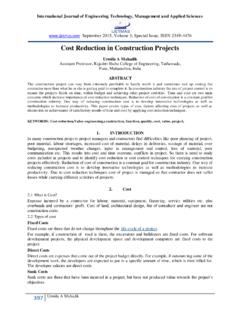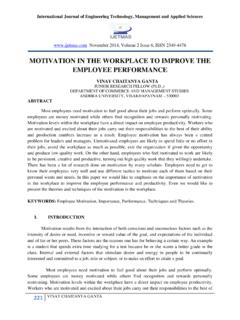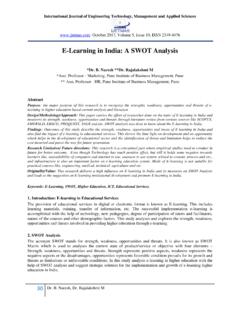Transcription of Manufacturing Bricks from Sand and Waste Plastics
1 International Journal of Engineering Technology, Management and Applied Sciences March 2017, Volume 5 Issue 3, ISSN 2349-4476 426 Lairenlakpam Billygraham Singh, Pongsumbam Boss Singh, Loukham Gerion Singh, Suresh Thokchom Manufacturing Bricks from Sand and Waste Plastics Lairenlakpam Billygraham Singh NHPC Limited, Loktak, Manipur. Loukham Gerion Singh Pongsumbam Boss Singh Suresh Thokchom* *Associate Professor, Department of Civil Engineering, MIT Manipur. ABSTRACT The present work is performed to manufacture Bricks or building blocks from sand and Waste Plastics . The Bricks are produced by mixing Waste plastic and sand after heating at 200oC.
2 Two specimens of Bricks , one with sand and Waste CDs; another with sand and Waste water bottles are produced and tested for some physical and mechanical properties . The sand-plastic Bricks are lightweight and present a waxy surface. The results of sand plastic Bricks are compared with those of traditional local Bricks . It is observed that sand plastic Bricks have low water absorption, low apparent porosity and high compressive strength. Keywords- Compact discs (CD), Waste water bottles, bulk density, compressive strength, durable 1. INTRODUCTION Building materials like Bricks , concrete block, tiles, etc.
3 Are popularly used in construction. However, these materials are expensive and hence common people find it difficult to easily afford them. Moreover, these building materials require certain specific compositions to obtain desired properties . Plastic is one of the recent engineering materials which have appeared in the market all over the world. It is a material consisting of a wide range of synthetic or semi-synthetic organic compounds that are malleable and can be molded into solid objects. By definition, Plastics can be made to different shapes when they are heated. It exists in the different forms such as cups, furniture, basins, plastic bags, food and drinking containers and they become Waste material.
4 Accumulation of such wastes can result into hazardous effects to both human and plant life. Therefore, need for proper disposal, and if possible, use of these wastes in their recycled forms arises. Plastic Waste is increasing day by day throughout the world. Where proper garbage collection system is not available, Waste Plastics are strewn everywhere which becomes eyesore. It also pollutes the environment. A large amount of Waste plastic are discarded or burned which leads to the contamination of environment and air. The large volume of materials required for infrastructure construction is potentially a major area for the reuse of Waste materials.
5 Recycling the Plastics has advantages since it is widely used worldwide and has a long service life, which means that the Waste is being removed from the Waste stream for a long period [1]. Reuse of Waste Plastics has environmental benefits not only related to the safe disposal of bulk Waste , but also to the reduction of environmental impacts that arises due to burning of Plastics . Use of Waste Plastics in infrastructure construction has been tried and reported [2,3]. Manufacturing Bricks with soil and plastic wastes by mixing after heating is also reported by Puttaraj MH et al.[4]. The present research is performed to study the properties of Bricks manufactured by mixing sand and Waste Plastics .
6 This study is expected to provide some information regarding the suitability of such sand plastic Bricks for use in construction industry. 2. EXPERIMENTAL Materials The Plastics used in the experimental program are Waste compact disc (CD) and Waste water bottles. River sand was sourced from local supplier. The sand has specific gravity of and fineness modulus of Preparation of Specimen The collected Waste CDs and plastic water bottles are cleaned in water and dried properly before being cut into small pieces to enable easy heating. The plastic pieces and sand are taken in a International Journal of Engineering Technology, Management and Applied Sciences March 2017, Volume 5 Issue 3, ISSN 2349-4476 427 Lairenlakpam Billygraham Singh, Pongsumbam Boss Singh, Loukham Gerion Singh, Suresh Thokchom proportion of 1: (1 plastic : sand) by weight and are heated in separate containers at approximately 200oC.
7 The heated materials are then mixed to get a homogenous mix and then poured into cube moulds of x x mm size. After cooling it for 10 hours in the mould, the specimens are demoulded and immersed in water for 24 hours before being removed for testing. Testing of Specimen The samples were tested for water absorption, bulk density, apparent porosity and compressive strength. In addition, normal clay Bricks collected from a local factory were also tested to compare with those of sand plastic brick specimens. The photographs of sand plastic Bricks are shown in Figure 1. The sand plastic Bricks present a waxy shining surface which is aesthetically appealing.
8 Bricks made from sand and Waste compact discs (spec. ID- CD) appear dark whereas specimen made from sand and Waste water bottles ( ) appears lighter. Figure 1: Sand Plastic Bricks 3. RESULTS AND DISCUSSION Bulk Density The bulk density of specimens is presented in Figure 2. It is observed that PB specimen ( Bricks made from sand and Waste plastic bottles) has the minimum bulk density among the three. Generally sand plastic Bricks are lighter when compared to normal clay Bricks . Of the three different specimens, Bricks made from sand and Waste water bottles give the lowest bulk density. Lower bulk density of sand plastic Bricks could help in reduction of dead loads of structures.
9 Reduction of dead loads of structures could lower construction costs and hence improve economy. Figure 2: Bulk density of specimens Water absorption Water absorption of brick specimens are tested and shown in Figure 3. The sand plastic Bricks , both CD and PB specimen exhibits very low water absorption at and respectively. These values are much lower than those specified by IS codes for first class Bricks . Since the water absorption values of sand plastic Bricks are much lower than those of normal Bricks , it is very likely that these Bricks shall be superior in terms of durability properties . Figure 3: Water Absorption of specimens Apparent Porosity Apparent porosity is an indirect measure of durability of specimens.
10 Figure 4 presents the apparent porosity of the sand plastic specimens and normal clay Bricks . As expected, a sand plastic brick , both CD and PB brick specimens shows lesser apparent porosity. CD brick specimens have apparent porosity as low as whereas PB and NB specimens recorded an apparent porosity of and respectively. The results of apparent porosity are an indication that sand plastic Bricks will be far more durable than the normal clay Bricks . Figure 4: Apparent Porosity of specimens Compressive Strength Bricks should have a specified minimum compressive strength so that they can be used in construction works.


